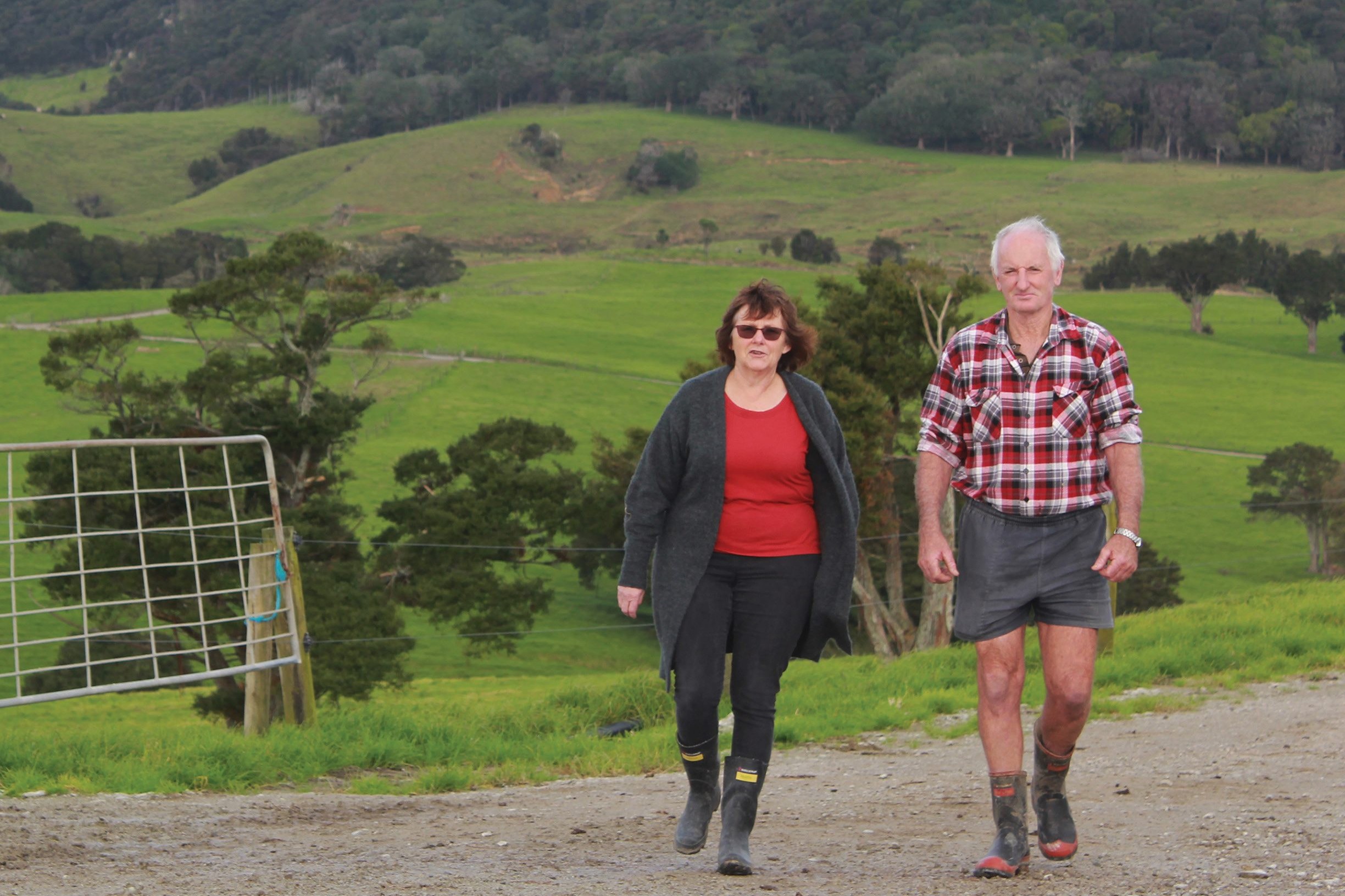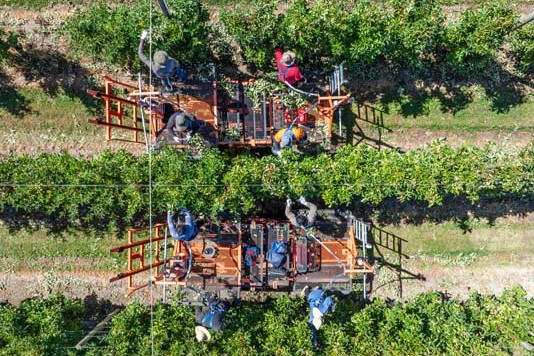Fertile farming in the north
First Paddy and Debbie Thornton were share milkers, then they bought the farm, and more. By Delwyn Dickey.

Paddy and Debbie Thornton farm in a beautiful spot.
The countryside around Maungaturoto in lower Northland has rolling green pastures with bush-clad high hills to the south. To the northeast are the rugged Brynderwyn Ranges – the gateway to the “winterless north” with the sweeping coastline of Bream Bay beyond.
From the farm a scar on the slopes of the ranges is clearly visible at the moment, revealing clay beneath – a result of deluges earlier in the year. The slip closed State Highway 1, which snakes up and over the steep hills, with detours in place for weeks.
It’s been the third wet spring in a row which also continued over into summer this year.
Poor clay soil is typical for this area and also sits beneath the lush pasture their animals feed on.
Having farmed here for the last 36 years, first as 50/50 share milkers before buying the property, Paddy and Debbie know the conditions on their 179-hectare farm inside out.
And while high empty rates across the country have raised concern this season, the Thorntons have maintained a remarkable success rate for getting the “girls” in their herd pregnant, with just a 7% empty rate this season.

Paddy knows a thing or two about dairying. He’s been farming all his life, leaving school at 14 to help his mother run the family farm after his father died.
At 91 she has only stopped looking after the calves in the last few years.
“She still tells me how to farm and I still call her the boss,” Paddy says.
While he may have missed out on school qualifications, the years of dairy farming experience including more than 10 years of judging have seen Paddy gain industry smarts.
Also from a dairy farming family, Debbie opted to stay working off-farm during their married life, which has helped smooth financial bumps as well as spread business risk. She has put her office skills to good use doing all the administration for their business.
These combined skills have seen the business flourish with the couple owning two farms locally, a half share in a farm in the Bay of Islands – which has now been sold, and a third share in a Southland dairy farm.
But while he still manages their home farm along with 50/50 share milkers, Paddy would be the first to acknowledge he’s not actually sure how they manage to get so many of their cows regularly in-calf.
He unpacked his management style at a recent SMASH (Smaller Milk and Supply Herds) event held on the farm, so other farmers might glean any useful information from it.
Part of his success may come down to a low-pressure environment for the animals, he reckons.
In the past the Maungaturoto farm was always a System 1 with a lower stocking rate and no imported feed.
Having a low system farm has also worked better for managing the clay soils, Paddy says, by not transporting a lot of feed around the farm and reducing damage to soil structure.
Pasture, silage and summer cropping of turnips have been the mainstays of the feeding regime.
“Stocking rates are slightly higher now at 2.2 per hectare, and on these clay soils that’s pushing it, but we’ve never dropped under 2.”
After three wet La Nina springs in a row, with reduced pasture growth and the turnips not doing well, the farm has been moved up to a System 2 with a 60% palm kernel blend.
Coming to grips with this soggy weather initially saw them feeding from trailers. But concerns over young animals – which need the feed more – being bullied away by older cows, wastage in the wet, and with trailer tyres being damaged by animals standing on valves and breaking them, saw a move to in-shed feeding instead.
The $70,000 investment will ensure all animals are getting the two to three kilograms of feed they need, along with a bit of future proofing as the climate becomes more extreme, Paddy says.
A big believer in using minerals this generally means selenium, cobalt and a little copper. While he used to drench with these in the past, he now goes trough to trough. This starts at calving and continues through until mating.
Magnesium goes on the hay and is only fed to the springers – although the colostrum cows get a little, winding up just before mating.
Paddy admits he’s not sure how effective the minerals really are but reckons he is too scared to stop using them to find out.
Having experienced first-hand the kinds of pressures on the System 5 Kerikeri farm over nine years Paddy feels these high system farms put a lot more pressure on farmers and managers to perform, and sees them with not just higher stocking rates but also pushing the animals harder to perform outside their bodies’ normal boundaries.
Ironically, although it was producing more, with all the extra feed, machinery and labour requirements the Kerikeri farm never made them any money, he says.
The Southland farm operates as a System 3, and while it had a higher empty rate this year than the northern farms at 12%, it was still lower than the 18% average for the region, with some farms there as high as 25% empty.
A lower-system farm, along with having more moderate and achievable goals takes some of the pressure off, he reckons.
Keeping the cows healthy and in good condition all year round is a thread that runs through his management style – good animal health and fertility going hand-in-hand.
This becomes particularly important before calving and mating, especially for young animals, Paddy says. This is one reason he dries all the cows off at the end of March even if there is plenty of grass.
“They need that extra time to put on weight,” he says. “You’ll pay for it the next season if you continue.”
Good pasture management instead of bringing in supplements has always been a priority for Paddy and with the changing climate, putting more effort into pasture management will become even more important, he says.
“It’s too easy to simply go and buy in more supplements. Fresh pasture is better for the animal.”
Because of this, Paddy admits to being fairly heavy -handed with nitrogen over the years to get the most out of the pasture on the clay soil.
And despite being unhappy with some of the newer ryegrass varieties which he finds develop rust during their first year, making them unpalatable to the cows and not handling drier summer and autumn conditions well, he is reluctant to try other pasture species. Cocksfoot and tall fescue seem better able to handle drier climates and are becoming more popular in the north, but after spending so many months on the farm spraying out “old man” fescue, after his father died, Paddy doubts he’ll ever be able to bring himself to grow fescue again on purpose.
Once-a-day milking has become the norm in Northland these days. While he moves to twice-a day milking when there is a good supply of pasture Paddy is pedantic about a cow only doing once-a-day for at least four weeks after calving, and until she has cycled. She’ll stay on once-a-day longer if she is thinner or has had trouble calving.
This is to give the animal’s body a good chance to recover before mating, he says, and has this written into the sharemilking agreement.
The only exception is the colostrum cows which are milked twice-a-day from the start to get the colostrum into the vat as quickly as possible.
This routine effectively sees two herds until the end of mating when all the cows go on to twice-a-day, but again this comes down to pasture quality. The wet spring and summer this year delayed this until mid-January.
Trialing of collars has started on the southern farm and Paddy is pleased with how they have been performing. But for now, he is content to continue with his routine in the north doing heat detection in the paddock without any synchronisation. LIC Forward Packs are used extensively and after six weeks of artificial breeding (AB), including for the yearlings, the animals are out with the bulls for five weeks.
Getting the right numbers of bulls is important.
“You always lose money on bulls and they can wreck things, so you don’t want to get more than you need,” Paddy says.
But not having enough bulls can have serious consequences, as one local found out, contacting Paddy for advice after having a 29% empty rate.
Because his cows are in such good condition at the time of mating Paddy doesn’t usually keep carry-over cows. He works to the theory they are empty for a reason which may well be genetic, and he doesn’t want those genetics getting into the herd. With their two adult children off doing their own thing and dairying not on their radar Paddy is unsure what the future holds for the farm. The Maungaturoto area is becoming more popular, and farms like theirs close to the village are likely to be split up into lifestyle blocks in the future. It may be Paddy and Debbie will be the last to farm their piece of paradise.
Whatever the future holds, the cows on their farm will continue to be some of the healthiest around, with in-calf rates the envy of many other farmers.





